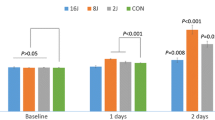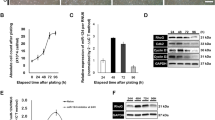Abstract
Purpose
The purpose of this study was to investigate the role of HtrA serine peptidase 1 (HTRA1) in the proliferation and migration of cells of the human retinal pigment epithelial cell line ARPE-19, and the possible mechanisms involved.
Methods
ARPE-19 cells were transduced by a recombinant lentiviral vector carrying HTRA1-shRNA to knockdown HTRA1 expression. Subsequent HTRA1 gene and HTRA1 protein levels in these cells and control cells were detected by quantitative real-time PCR and Western blot, respectively. Changes in cell proliferation and migration associated with the inhibition of HTRA1 expression were assessed, as well as changes in the mRNA levels of transforming growth factor beta 1 (TGFB1), bone morphogenetic protein 4 (BMP4), and bone morphogenetic protein 2 (BMP2).
Results
The recombinant lentivirus carrying HTRA1-shRNA was successfully generated, as evidenced by reduced levels of HTRA1 mRNA and HTRA1 protein in ARPE-19 cells. The knockdown of HTRA1 in ARPE-19 cells was associated with reduced cellular proliferation and migration, and increased mRNA levels of TGF-β1, BMP4, and BMP2.
Conclusions
Silence of the HTRA1 gene was associated with significantly higher levels of TGF-β1, BMP4, and BMP2 mRNA and reduction in the proliferation and migration of ARPE-19 cells.






Similar content being viewed by others
References
Bandello F, Lafuma A, Berdeaux G (2007) Public health impact of neovascular age-related macular degeneration treatments extrapolated from visual acuity. Invest Ophthalmol Vis Sci 48(1):96–103
Bird AC (2003) The Bowman lecture. Towards an understanding of age-related macular disease. Eye (Lond) 17(4):457–466
Xu L, Wang Y, Li Y, Wang Y, Cui T, Li J, Jonas JB (2006) Causes of blindness and visual impairment in urban and rural areas in Beijing: the Beijing Eye Study. Ophthalmology 113(7):1134 e1–11
Strauss O (2005) The retinal pigment epithelium in visual function. Physiol Rev 85(3):845–881
Sonoda S, Sreekumar PG, Kase S, Spee C, Ryan SJ, Kannan R, Hinton DR (2009) Attainment of polarity promotes growth factor secretion by retinal pigment epithelial cells: relevance to age-related macular degeneration. Aging (Albany NY) 2(1):28–42
Yu AL, Fuchshofer R, Kook D, Kampik A, Bloemendal H, Welge-Lussen U (2009) Subtoxic oxidative stress induces senescence in retinal pigment epithelial cells via TGF-beta release. Invest Ophthalmol Vis Sci 50(2):926–935
Seddon JM, Chen CA (2004) The epidemiology of age-related macular degeneration. Int Ophthalmol Clin 44(4):17–39
Montezuma SR, Sobrin L, Seddon JM (2007) Review of genetics in age related macular degeneration. Semin Ophthalmol 22(4):229–240
Rakic JM (2006) [Multifactorial influences on age-related macular degeneration]. Bull Soc Belge Ophtalmol (301):9–11
Luo L, Harmon J, Yang X, Chen H, Patel S, Mineau G, Yang Z, Constantine R, Buehler J, Kaminoh Y, Ma X, Wong TY, Zhang M, Zhang K (2008) Familial aggregation of age-related macular degeneration in the Utah population. Vision Res 48(3):494–500
Seddon JM, Cote J, Page WF, Aggen SH, Neale MC (2005) The US twin study of age-related macular degeneration: relative roles of genetic and environmental influences. Arch Ophthalmol 123(3):321–327
Jakobsdottir J, Conley YP, Weeks DE, Mah TS, Ferrell RE, Gorin MB (2005) Susceptibility genes for age-related maculopathy on chromosome 10q26. Am J Hum Genet 77(3):389–407
Fisher SA, Abecasis GR, Yashar BM, Zareparsi S, Swaroop A, Iyengar SK, Klein BE, Klein R, Lee KE, Majewski J, Schultz DW, Klein ML, Seddon JM, Santangelo SL, Weeks DE, Conley YP, Mah TS, Schmidt S, Haines JL, Pericak-Vance MA, Gorin MB, Schulz HL, Pardi F, Lewis CM, Weber BH (2005) Meta-analysis of genome scans of age-related macular degeneration. Hum Mol Genet 14(15):2257–2264
Wang G (2014) Chromosome 10q26 locus and age-related macular degeneration: a progress update. Exp Eye Res 119:1–7
Launay S, Maubert E, Lebeurrier N, Tennstaedt A, Campioni M, Docagne F, Gabriel C, Dauphinot L, Potier MC, Ehrmann M, Baldi A, Vivien D (2008) HtrA1-dependent proteolysis of TGF-beta controls both neuronal maturation and developmental survival. Cell Death Differ 15(9):1408–1416
Karagiannis TC, El-Osta A (2005) RNA interference and potential therapeutic applications of short interfering RNAs. Cancer Gene Ther 12(10):787–795
Jakobsson J, Lundberg C (2006) Lentiviral vectors for use in the central nervous system. Mol Ther 13(3):484–493
De Luca A, De Falco M, Severino A, Campioni M, Santini D, Baldi F, Paggi MG, Baldi A (2003) Distribution of the serine protease HtrA1 in normal human tissues. J Histochem Cytochem 51(10):1279–1284
Valori CF, Ning K, Wyles M, Azzouz M (2008) Development and applications of non-HIV-based lentiviral vectors in neurological disorders. Curr Gene Ther 8(6):406–418
Grau S, Richards PJ, Kerr B, Hughes C, Caterson B, Williams AS, Junker U, Jones SA, Clausen T, Ehrmann M (2006) The role of human HtrA1 in arthritic disease. J Biol Chem 281(10):6124–6129
Baldi A, De Luca A, Morini M, Battista T, Felsani A, Baldi F, Catricala C, Amantea A, Noonan DM, Albini A, Natali PG, Lombardi D, Paggi MG (2002) The HtrA1 serine protease is down-regulated during human melanoma progression and represses growth of metastatic melanoma cells. Oncogene 21(43):6684–6688
Chien J, Staub J, Hu SI, Erickson-Johnson MR, Couch FJ, Smith DI, Crowl RM, Kaufmann SH, Shridhar V (2004) A candidate tumor suppressor HtrA1 is down regulated in ovarian cancer. Oncogene 23(8):1636–1644
Chien J, Ota T, Aletti G, Shridhar R, Boccellino M, Quagliuolo L, Baldi A, Shridhar V (2009) Serine protease HtrA1 associates with microtubules and inhibits cell migration. Mol Cell Biol 29(15):4177–4187
Chien J, Campioni M, Shridhar V, Baldi A (2009) HtrA serine proteases as potential therapeutic targets in cancer. Curr Cancer Drug Targets 9(4):451–468
Oka C, Tsujimoto R, Kajikawa M, Koshiba-Takeuchi K, Ina J, Yano M, Tsuchiya A, Ueta Y, Soma A, Kanda H, Matsumoto M, Kawaichi M (2004) HtrA1 serine protease inhibits signaling mediated by Tgfbeta family proteins. Development 131(5):1041–1053
Hill JJ, Tremblay TL, Cantin C, O’Connor-McCourt M, Kelly JF, Lenferink AE (2009) Glycoproteomic analysis of two mouse mammary cell lines during transforming growth factor (TGF)-beta induced epithelial to mesenchymal transition. Proteome Sci 7:2
Blobe GC, Schiemann WP, Lodish HF (2000) Role of transforming growth factor beta in human disease. N Engl J Med 342(18):1350–1358
Wang N, Eckert KA, Zomorrodi AR, Xin P, Pan W, Shearer DA, Weisz J, Maranus CD, Clawson GA (2012) Down-regulation of HtrA1 activates the epithelial-mesenchymal transition and ATM DNA damage response pathways. PLoS One 7(6):e39446
An E, Sen S, Park SK, Gordish-Dressman H, Hathout Y (2010) Identification of novel substrates for the serine protease HTRA1 in the human RPE secretome. Invest Ophthalmol Vis Sci 51(7):3379–3386
Supanji SM, Hasan MZ, Kawaichi M, Oka C (2013) HtrA1 is induced by oxidative stress and enhances cell senescence through p38 MAPK pathway. Exp Eye Res 112:79–92
Jones A, Kumar S, Zhang N, Tong Z, Yang JH, Watt C, Anderson J, Amrita FH, McCloskey M, Luo L, Yang Z, Ambati B, Marc R, Oka C, Zhang K, Fu Y (2011) Increased expression of multifunctional serine protease, HTRA1, in retinal pigment epithelium induces polypoidal choroidal vasculopathy in mice. Proc Natl Acad Sci U S A 108(35):14578–14583
Nakayama M, Iejima D, Akahori M, Kamei J, Goto A, Iwata T (2014) Overexpression of HtrA1 and exposure to mainstream cigarette smoke leads to choroidal neovascularization and subretinal deposits in aged mice. Invest Ophthalmol Vis Sci 55(10):6514–6523
Vierkotten S, Muether PS, Fauser S (2011) Overexpression of HTRA1 leads to ultrastructural changes in the elastic layer of Bruch’s membrane via cleavage of extracellular matrix components. PLoS One 6(8):e22959
Wang G, Dubovy SR, Kovach JL, Schwartz SG, Agarwal A, Scott WK, Haines JL, Pericak-Vance MA (2013) Variants at chromosome 10q26 locus and the expression of HTRA1 in the retina. Exp Eye Res 112:102–105
Wang YW, Liou NH, Cherng JH, Chang SJ, Ma KH, Fu E, Liu JC, Dai NT (2014) siRNA-targeting transforming growth factor-beta type I receptor reduces wound scarring and extracellular matrix deposition of scar tissue. J Invest Dermatol 134(7):2016–2025
Kretova M, Sabova L, Hodny Z, Bartek J, Kollarovic G, Nelson BD, Hubackova S, Luciakova K (2014) TGF-beta/NF1/Smad4-mediated suppression of ANT2 contributes to oxidative stress in cellular senescence. Cell Signal 26(12):2903–2911
Acknowledgments
This research is supported by the National Natural Science Foundation of China Grant 81070734, the Beijing Education Commission Grant KZ201110025028, and the Beijing Municipal Health Bureau Grant 2009208.
Author information
Authors and Affiliations
Corresponding author
Rights and permissions
About this article
Cite this article
Pei, X., Ma, K., Xu, J. et al. Inhibition of cell proliferation and migration after HTRA1 knockdown in retinal pigment epithelial cells. Graefes Arch Clin Exp Ophthalmol 253, 565–572 (2015). https://doi.org/10.1007/s00417-014-2901-2
Received:
Revised:
Accepted:
Published:
Issue Date:
DOI: https://doi.org/10.1007/s00417-014-2901-2




